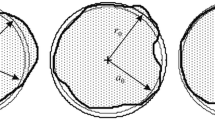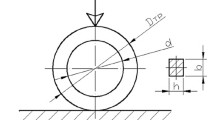Abstract
The dependence of porosity θ of the spongy titanium-based powder material on stress state coefficient k during the plastic deformation with the prevailing effect of the uniform compression is investigated. Based on the results found in previous works, the family of yield curves with a variable porosity is plotted on the σ–T plane. The yield criterion of the powder material is based on the Modified Drucker–Prager Cap Model. Straight lines corresponding to various values of stress-state coefficient k = σ/T, where σ is the average hydrostatic stress and T is the intensity of tangential stresses, are represented in the graph of the geometric interpretation of the accepted plasticity model. To formulate the relation of porosity (θ, %), average normal stress (\(\bar {\sigma }\)), expressed in the dimensionless form, and stress-state coefficient k, intersection points of the family of curves corresponding to generatrices of yield surfaces on the σ–T plane and radial straight lines, are used. This results in the derivation of the equation of the θ = θ (\(\bar {\sigma }\), k) form. To verify the adequacy of this relationship, the experimental part of the investigation is fulfilled. Powder billets preliminarily compacted at a pressure of 1000 MPa and temperature 325°C are subjected to electroerosion cutting along the axial section to form planar samples (templates). Several characteristic segments are selected on the template surface to determine the local surface porosity by quantitative metallography. The stress state was additionally determined in representative segments by the numerical simulation. Values of bulk plastic strain (\(\varepsilon _{{v}}^{{{\text{pl}}}}\)), intensities of tangential stresses (T), and hydrostatic normal stress (σ) are calculated in axial section zones corresponding to the regions under study. It is shown that the stress state coefficient insignificantly affects the porosity upon its variation in a rather broad range (k = –10 to –0.86).



Similar content being viewed by others
REFERENCES
Nesterenko, A.V., Novozhonov, V.I., Zalazinskii, A.G., and Skripov, A.V., Influence of temperature on compactibility of briquettes of titanium sponge alloyed with hydrogen, Russ. J. Non-Ferrous Met., 2015, vol. 56, no. 3, pp. 287–292.
Helle, A.S., Easterling, K.E., and Ashby, M.F., Hot-isostatic pressing diagrams: new developments, Acta Metal., 1985, vol. 33, no. 12, pp. 2163–2174.
Swinklers, F.B., Wilkinson, D.S., Arzt, E., and Ashby, M.F., Mechanisms of hot isostatic pressing, Acta Metal., 1983, vol. 31, no. 11, pp. 1829–1840.
Nissel, C., HIP diffusion bonding, Powder Metall. Int., 1984, vol. 16, no. 3, pp. 113–116.
Hartong, B., Jerier, J.F., Doremus, P., Imbault, D., and Donze, F.V., Modeling of high-density compaction of granular materials by the discrete element method, Int. J. Sol. Struct., 2009, vol. 46, nos. 18–19, pp. 3357–3364.
Maksimenko, A.L., Simulation of deformation hardening of porous and powder materials in extrusion processes, Poroshk. Metall., 2014, nos. 11/12, pp. 3–14.
Martynova, I.F. and Shtern, M.B., Plasticity equations of porous solids considering true strain of the base material, Poroshk. Metall., 1978, no. 1, pp. 23–29.
Xin, X.J., Jayaraman, P., Daehn, G.S., and Wagoner, R.H., Investigation of yield surface of monolithic and composite powders by explicit finite element simulation, Int. J. Mech. Sci., 2003, vol. 45, no. 4, pp. 707–723.
Loginov, Yu.N., Stepanov, S.I., and Khanykova, E.V., Effect of pore architecture of titanium implants on stress-strain state upon conversion, Solid State Phenom., 2017, vol. 265, pp. 606–610.
Maksimenko, A.L., Mikhailov, O.V., and Shtern, M.B., Effect of the morphology of pores on the regularities of plastic-deformation of porous bodies. 2. Evolution of the shape of pores in the process of plastic deformation, Soviet Powder Metall. Met. Ceram., 1992, vol. 31, no. 5, pp. 381–385.
Orlova, E.V. and Panova, I.M., Analysis of the densification process of discrete materials under hydrostatic pressure, Kuzn.-Shtamp. Proizv. Obrab. Mater. Davl., 2016, no. 6, pp. 10–15.
Zalazinskii, A.G. and Polyakov, A.P., Model of plastically compressed material and its application to the study of the extrusion process of a porous billet, Prikl. Mekh. Tekh. Fiz., 2002, no. 3, pp. 140–151.
Kushch, V.I., Podoba, Ya.O., and Shtern, M.B., Effect of micro-structure on yield strength of porous solid: A comparative study of two simple cell models, Comput. Mater. Sci., 2008, vol. 42, no. 1, pp. 113–121.
Grigor’ev, A.K., Rudskoi, A.I., and Kolesnikov, A.V., Mathematical model of the elastoplastic deformation process of porous sintered materials, Poroshk. Metall., 1992, no. 12, pp. 1–10.
Perel’man, V.E., Analysis of powder materials compaction under hydrostatic loading, Poroshk. Metall., 1977, no. 9, pp. 15–21.
Ogbonna, N. and Fleck, N.A., Compaction of an array of spherical particles, Acta Metal. Mater., 1995, vol. 43, no. 2, pp. 603–620.
Loginov, Yu.N., Babailov, N.A., and Pervukhina, D.N., Simulation of porous material compaction process using Abaqus software, Kuzn.-Shtamp. Proizv. Obrab. Mater. Davl., 2015, no. 6, pp. 45–48.
Zhou, M., Huang, S., Hu, J., Lei, Y., Zou, F., Yan, S., and Yang, M., Experiment and finite element analysis of compaction densification mechanism of Ag–Cu–Sn–In mixed metal powder, Powder Technol., 2017, vol. 313, pp. 68–81.
Druyanov, B.A., Prikladnaya teoriya plastichnosti poristykh tel (Applied Theory of Plasticity of Porous Solids), Moscow: Mashinostroenie, 1989.
Laptev, A.M., Plasticity criteria for porous materials, Poroshk. Metall., 1982, no. 7, pp. 12–17.
DorMohammedi, H. and Khoei, A.R., A three-invariant cap model with isotropic-kinematic hardening rule and associated plasticity for granular materials, Int. J. Sol. Struct., 2008, vol. 45, no. 2, pp. 631–656.
DiMaggio, F.L. and Sandler, I.S., Material model for granular soils, J. Eng. Mech. Div., 1971, vol. 97, no. 3, pp. 935–950.
Gurson, A.L., Continuum theory of ductile rupture by void nucleation and growth: Part 1. Yield criteria and flow rules for porous ductile media, J. Eng. Mater. Technol. Trans. ASME, 1977, vol. 99, no. 1, pp. 2–15.
Shima, S. and Oyane, M., Plasticity theory for porous metals, Int. J. Mech. Sci., 1976, vol. 18, no. 6, pp. 285–291.
Doraivelu, S.M., Gegel, H.L., Gunasekera, J.S., Malas, J.C., Morgan, J.T., and Thomas, J.F., A new yield function for compressible P/M materials, Int. J. Mech. Sci., 1984, vol. 26, nos. 9–10, pp. 527–535.
Lee, D.N. and Kim, H.S., Plastic yield behavior of porous metals, Powder Metall., 1999, vol. 41, no. 2, pp. 121–141.
Park, S.J., Han, H.N., Oh, K.H., and Lee, D.N., Model for compaction of metal powders, Int. J. Mech. Sci., 1976, vol. 18, no. 6, pp. 285–291.
Biswas, K., Comparison of various plasticity models for metal powder compaction processes, J. Mater. Proc. Technol., 2005, vol. 166, no. 1, pp. 107–115.
Drucker, D.C. and Prager, W., Soil mechanics and plastic analysis for limit design, Quart. Appl. Mat., 1952, vol. 10, no. 2, pp. 157–165.
Resende, L. and Martin, J.B., Formulation of Drucker–Prager cap model, J. Eng. Mech. ASCE, 1985, vol. 111, no. 7, pp. 855–881.
Dassult Systemes Simulia Corp., Abaqus Theory Manual, accessed June 13, 2013.
Kolmogorov, V.L., Loginov, Yu.N., Parshakov, S.I., and Shilov, S.V., Revisiting the hypothesis of a single curve for powder materials, in Obrabotka metallov davleniem (Pressure Treatment of Metals), Sverdlovsk: Kirov UPI, 1981, pp. 47–50.
Berezin, I., Nesterenko, A., Zalazinskii, A. and Kovacs, G., Influence of stress state conditions on densification behavior of titanium sponge, Acta Polytech. Hungar., 2017, vol. 14, no. 6, pp. 153–168.
Berezin, I.M., Nesterenko, A.V., and Zalazinskii, A.G., Identification of the Druker–Prager yield condition and modeling of compaction of the plasticized titanium feedstock, Russ. J. Non-Ferrous Met., 2017, vol. 58, no. 3, pp. 297–302.
Author information
Authors and Affiliations
Corresponding authors
Ethics declarations
The authors claim that they have no conflict of interest.
Additional information
Translated by N. Korovin
About this article
Cite this article
Zalazinskii, A.G., Nesterenko, A.V. & Berezin, I.M. Study of Compaction of the Titanium Powder by the Experimental-Analytical Method. Russ. J. Non-ferrous Metals 60, 499–503 (2019). https://doi.org/10.3103/S1067821219050183
Received:
Revised:
Accepted:
Published:
Issue Date:
DOI: https://doi.org/10.3103/S1067821219050183




